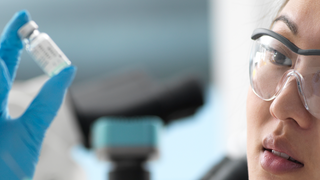With the COVID-19 disease sweeping the world, a global race is underway to develop therapies to help alleviate the illness, but more importantly, a vaccine to cure it.
As governments shut down their economies, halt international travel, and compete to expand their influence as others turn inwards to concentrate on battling the pandemic within their borders, the sprint to be the first to find a workable vaccine is turning increasingly geopolitical. The reasons why Australian scientists are playing an outsized role in the race to understand the virus and develop a vaccine holds lessons for how Canberra re-thinks national resilience after the pandemic.
For instance, China has reportedly committed 1,000 military scientists to the effort. President Trump reportedly sought to lure a German biomedical company – and its in-development-vaccine - to America so the United States could be the first to access it. The EU committed more funding to the company so it would stay on the continent.
But the roots of government and military involvement in the race for the vaccine go back much further. Development efforts centred around new DNA and RNA-based vaccines – some of the most promising candidates that utilise genetic material - can trace their funding origins to the US Defense Research Advanced Projects Agency, or DARPA.
DNA and RNA vaccines are novel. More traditional vaccines – the first of which appeared in the 18th Century - work by injecting a less virulent or inactive form of the virus, conditioning the body’s immune system to recognise it and produce antibodies for it. DNA and RNA vaccines work on the same principle, but instead use messenger-like RNA to instruct the body’s cells to produce the specific proteins – or sign posts - of the virus the immune system will recognise. Theoretically – as they haven’t been widely used - they are safer, far faster to make and may provide more effective protection.
In 2011, DARPA gave an initial US$33.1 million grant to CureVac, a small biomedical company that was one of the first to work on translating the theory into a workable RNA vaccine. By 2013, CureVac launched its first trial of an RNA vaccine for rabies. CureVac is now working on a low-dose RNA vaccine for COVID-19.
In hindsight, DARPA’s funding of rapid RNA and DNA vaccine technologies – if they work – will prove why the agency exists in the first place.
The American company leading the COVID-19 vaccine race is Moderna, another recipient of DARPA grant funding. DARPA awarded Moderna a total of US$65 million in 2013, which helped give the company and its largely-untested RNA platform technology credibility in the eyes of other investors. The company raised $600 million in its IPO in 2018. Moderna conducted its first human-trials of its COVID-19 RNA vaccine earlier this month, an incredibly fast pace for vaccine development which usually runs on the timescale of decades.
DARPA is unique among many US research agencies. It is staffed mainly by scientific experts from industry, academia and the military who are seconded into the agency for 3-5 years. Its portfolio is organised around themes and is loosely structured, focusing not on tactical objectives but on the “frontiers of physics, chemistry and biology.” Ultimately, while other US research agencies are largely focused on specific technologies or weapon systems, DARPA is set on catapulting America’s technological advantage through high-risk, high-reward technology programs.
In hindsight, DARPA’s funding of rapid RNA and DNA vaccine technologies – if they work – will prove why the agency exists in the first place. Created following the Soviet Union’s 1957 launch of the Sputnik satellite, DARPA exists to “prevent technological surprise.” In what may be an act of foresight, DARPA stood up a new program in 2018 called the Pandemic Prevention Program (P3). The Program aims to build a “scalable, adaptable, rapid response program capable of producing relevant numbers of doses against any known or previously unknown infectious threat within 60 days of identification of such threat.”
Separate from other RNA vaccine development programs, P3 has also granted funds to companies working on ‘short-term’ vaccines based on similar approaches that would stimulate anti-body responses for “weeks to months” rather than providing permanent protection like those Moderna or CureVac are working on. These measures would help contain the outbreak, provide protection for front-line health workers and the most vulnerable while a permanent vaccine found, all within 60 days. Likely with an eye towards developing methods to defend against biological agents, AbCellera – a Vancouver-based company that is a member of the P3 program – has already started the search for relevant COVID-19 antibodies.
DARPA has also funded some of Australia’s leading medical scientists. In 2017, DARPA sponsored a joint effort between the Queensland University of Technology, the Duke-National University of Singapore Medical School and the Queensland Institute of Medical Research to “develop novel and adaptive therapeutic countermeasures to prevent or treat dengue infection.” The program was part of a broader effort to find new treatments for “fast-evolving viruses such as influenza, Zika, Ebola, Dengue and Chikungunya.”
Australia’s scientific role in the global COVID-19 response
While some of the technologies DARPA has funded are leading the way towards a COVID-19 vaccine, Australia is also set to play a potentially critical role in how the world responds. Considering our size, it’s notable Australia has had some world firsts in the ongoing global research and development effort into better understanding the SARS-CoV-2 virus.
Considering our size, it’s notable Australia has had some world firsts in the ongoing global research and development effort into better understanding the SARS-CoV-2 virus.
In late January 2020, the Peter Doherty Institute for Infection and Immunity at the University of Melbourne was the first laboratory to replicate the virus outside of China. Additional live samples of the virus will allow researchers to accelerate work on developing therapies, vaccines and conduct further experiments on the virus. A little over a month later, the same laboratory was the first to map out how the human immune system responds to the disease, paving the way for more detailed scientific work on immune responses.
Even more importantly, researchers at the University of Queensland are at the leading global edge of vaccine development. UQ is experimenting with another novel technological approach involving a “molecular clamp” that helps stabilise vaccines, as well as working with industry to stand-up the ability to mass produce the vaccine simultaneously once a suitable candidate is found. The team at UQ was one of three initial programs sponsored by the Coalition for Epidemic Preparedness Innovations alongside Moderna and Inovio. The Coalition is a recently established global partnership between governments and NGOs with the aim of investing in the rapid development of new infectious disease vaccines.
In the case of this crisis, we are fortunate that the medical and health sciences is Australia’s largest R&D sector, receiving just under a third of all public and private R&D funding – or $3.08 billion - in higher education institutes in 2016. This is triple the second highest funding field – engineering – which receives $1.14 billion in funding support. A further $1.02 billion was spent on biological sciences. Considering medical and health science research in Australia was receiving only $668 million in funding in 2000, funding in the field has grown five-fold over the past two decades.
These achievements add resilience to Australia’s ability to address COVID-19, allows our government agencies and decision makers to have better information for understanding the virus, and gives us a potential ability to aid the response of our neighbours in Southeast Asia and the Pacific. This should be one of the biggest lessons following this pandemic. Similar to DARPA’s approach, only through long-term investments in R&D can we be prepared for global strategic, social and technological shocks.






